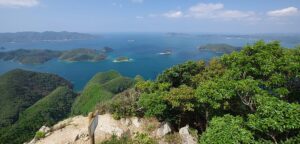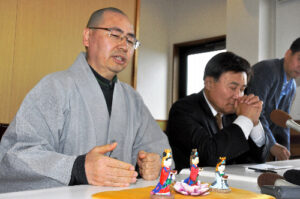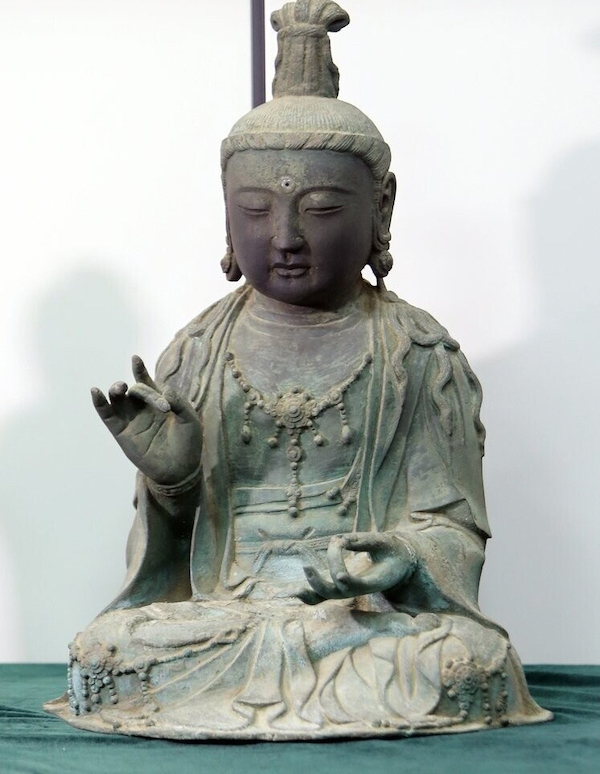
Top of Mount Shiroyama and Aso Bay in Tsushima, photo by Irisgazer, 4 October 2019, Public Domain Mark 1.0
South Korea’s High Court ruled on October 26, 2023 that a Buddhist statue stolen from the Kannonji temple in Japan in 2012 should be returned to it. The 2012 theft took place on Japan’s Tsushima Island, which lies in the straits midway between the Japanese mainland and the Korean Peninsula. Thieves from Korea took two statues from the island – a bronze standing statue of Tathagata Buddha from a Shinto shrine and a statue of the Kanzeon Bosatsu Zazo Bodhisattva from the Kannonji temple and brought them back to Korea by boat.
When the thieves were caught in 2013 trying to sell the statues, the Tathagata Buddha, which had long been designated an important cultural property by Japan’s government, was returned to Japan. The Kanzeon Bosatsu Zazo Bodhisattva also had protected cultural property status in Nagasaki Prefecture under Japan’s Law of Cultural Properties.
Nonetheless, the Kanzeon Bosatsu Zazo Bodhisattva was claimed by a Korean temple at Buseoksa as originally belonging to Korea. The Buseoksa temple requested and was granted a temporary injunction by a local court to prevent the sculpture from going back to Japan. The Korean temple claimed that writing found inside the statue said that it was made at Buseoksa in 1330. The temple alleged that the statue had been looted; it stated that documentation of five raids in the region by Japanese “wako” pirates between 1352 and 1381 were sufficient circumstantial evidence for a theft that occurred 600 years ago.

Wonwoo, head of the Buseoksa Temple in Korea, speaks at a news conference in Tsushima, Nagasaki Prefecture, on March 14, 2017 in front of the miniature figures he had intended to give the Kannonji temple. (Tatsuro Kawai)
The Venerable Wonwoo, chief priest of Buseoksa Temple, attempted to use the return of the statue as part of a campaign to bring back an alleged 70,000 Korean artifacts that have been ‘stolen’ and taken to Japan over the centuries. The claim by the Korean temple caused considerable furor at a time when Japanese-Korean relations were already sensitive. For the head of the Korean temple, the Bodhisattva appears to have been a proxy for historical abuses done in Korea by Japan. As relations between the two countries waxed positive or turned unfriendly in recent years, the Korean and Japanese governments have heightened or minimized the statue’s return as part of diplomatic efforts. Rapprochement, or at least settlement appears at times to have been stymied by the Buseoksa head monk’s insistence on seeing the 2012 theft as a righteous act of repatriation rather than a criminal taking for profit.
Korea’s government commissioned a study in 2014 to determine the validity of the claim of the statue’s theft by pirates, but could not connect the raids with the statue, concluding only that the statue went to Japan “by a process that was not ordinary.” The Buseoksa Temple then filed suit against the Korean government, which held the statue in storage, demanding that it be placed in its temple. Echoing a popular argument in repatriation circles today, the chief priest said that “Cultural property is only meaningful when it is found in the place where it originally belonged.”
In January 2017, the local Daejon District Court in southern Korea ordered the statue to be given to the Buseoksa Temple. Tensions between Japan and Korea only worsened when the Chief priest traveled to Tsushima soon after and attempted to meet with priests of the Kannonji temple. He brought three miniature plastic female figures sold as the temple’s “mascots” to tourists and a newly made bronze statue as a symbol of renewed friendship. When he presented the plastic figurines at a press conference in Japan as an appropriate if symbolic recompense, it is not surprising that the Japanese monks refused to meet with him.
-130x130.jpg)
Ceiling painting of a Chinese trumpet vine inside the Kannonji Temple, Kawahara Keiga, 1786, 18 July 2014, Public Domain.
The monks of the Kannonji temple on Tsushima reacted with disbelief to the Korean lower court’s decision that the Bodhisattva belonged to Korea. Setsuryo Tanaka, the longtime chief priest of the Kannonji temple, pointed out that the temple is a branch of the Seizanji temple, founded in 1512 to promote cultural exchange between Japan and Korea. The supposedly stolen statue, along with many other statues and manuscripts, were undoubtedly imported from Korea to Seizanji. Regarding the supposed theft by pirates, Tanaka said that it was “highly unlikely that something obtained through a bad deed would be enshrined.”
Japan’s government responded to the Daejeon District Court ruling granting the statue to the Buseoksa Temple on the highest level. Chief Cabinet Secretary Yoshihide Suga told the press that “the ruling is extremely regrettable,” adding that the Japanese government would ask for the statue’s expedient return.
In January of 2023, a High Court ruling in Daejeon overturned the 2017 District Court grant and said the Bodhisattva statue belonged to the Kannonji Temple – but the dispute eventually reached Korea’s highest court in October.
Korea’s Supreme Court said this week that evidence supports the claim that the current Buseoksa Temple is the same temple as the Seoju Buseok Temple, which is credited with the manufacture of the statue in the 14th century. However, it held that the 600 years that the statue had been in the Kannonji Temple in Japan established rights of ownership superseding that of the Buseoksa Temple.

Plastic figurines brought to Japan by the chief priest of Buseoksa Temple.
The Korean Supreme Court said that under the Japanese Civil Code, the Kannonji Temple was the statue’s rightful owner. While Tanaka, the head of the Kannonji Temple, expressed appreciation for the court’s “reasonable” ruling, Wonwoo, the head of the Buseoksa Temple, characterized it as “barbaric” and the “legalization of armed and illegal looting.” Clearly, while there is now apparent legal settlement, for the Buseoksa Temple, there is no reconciliation. It is regrettable, but perhaps in another 600 years there will be arguments about the souvenir plastic figurines as well.
 Kanzeon Bosatsu Zazo Bodhisattva from the Kannonji temple, gilt-bronze, held at Korea's National Institute of Cultural Heritage (Yonhap)
Kanzeon Bosatsu Zazo Bodhisattva from the Kannonji temple, gilt-bronze, held at Korea's National Institute of Cultural Heritage (Yonhap) 

